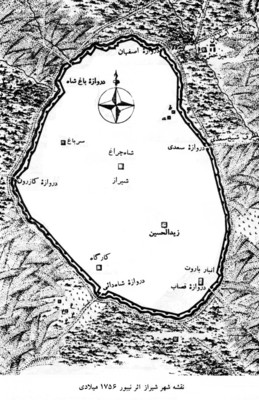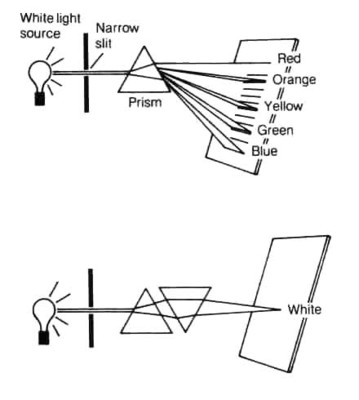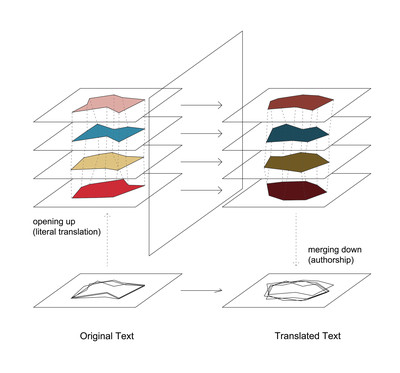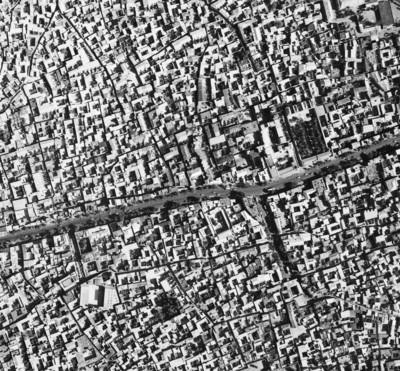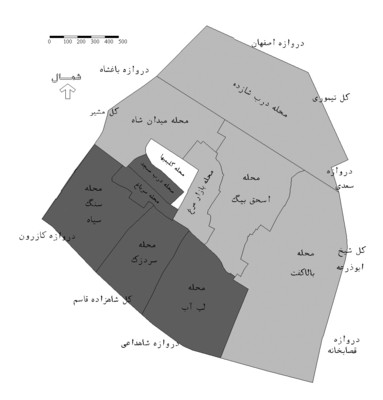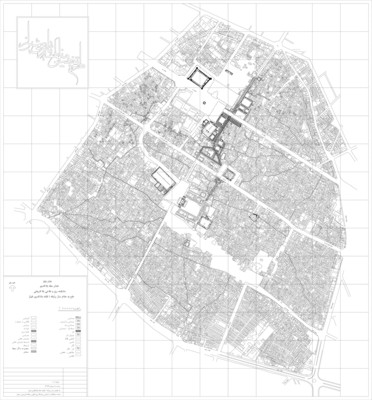… Let us let be or let us allow to be seen what does without the open embouchure.’ —Jacques Derrida, Truth in Painting
1.
A European friend once wrote to me, “I hope your country will open up one day.” What a strange phrase, I thought: ‘Open up!’ Is it not what the policeman shouts at the door? Open up to what or who? To modernization, to the global market, to capitalism. or to penetration? Or less aggressively, to adaptation? Or, ultimately, to translation? Or is it just opening up a space, some sort of a void?
What are the dangers of opening up? What are the politics of opening up or of translation as such?
2.
In the following text, I try to question the politics of such opening up in the domain of urbanism as the product of a translation taken in its greater significance. Translation as such, as argued by Morad Farhadpoor and others, is to be seen as a mode; one that can neatly serve as a theoretical model for thinking the cultural evolution of contemporary Iran, or, to use the terms of local intellectual discourse, for understanding the so-called ‘project of implanting modernity’. I try to show if such a model can prove coherent or tolerate its own implications and will take, among all possible texts, urbanism as my clarifying example. And this for a good reason: the urban fabric, too often appears as an objective manifestation of a multi-layered social reality, a ‘tracing pad’ of long-term social turbulence. But this all should wait. For the moment, we need to start from our project.
3.
According to the widely accepted formulation, modernization in Iran was, at its best, an incomplete process undertaken unevenly, with a considerable delay and little attention to the conditions of the place in which it was applied. Leaving aside those who reject modernization per se, studies of the subject mainly suppose two different alternatives for ‘implanting’ modernity, matched by two supposedly opposing methods of translation: the choice between fidelity to the original language or that of destination, or between literalness and interpretation, or radicalism and compromise. It will later become evident that both of these modes of ‘opening up’ to modernity prove too simplistic as valid models for the process of integrating modernization.
“Translation in its widest sense is the only true mode of thinking for us”, writes Morad Farhadpoor in The Depressed Reason. (Farhadpoor 1999, 13) Yet again, translation not in its widest sense but rather as a counterpart to authorship is, according to him, what we should insist upon, for “logically one cannot underline the importance of translation and claim at the same time that everything is translation. It is only in opposition to something other than itself that the importance of translation starts to show.” (Ibid. 14) Translation is a way of relating to the Other and understanding him, and as such, is “indispensable for any sort of self-consciousness” (Ibid. 16) Such a notion of translation is expanded by Omid Mehrgan in The Theology of Translation. Translation is a way of opening up and of keeping the openings open and the void empty. More than that, translation reveals fractures and fissures of the destination language and the situation of the corresponding society. Translation, to put it straightforwardly, “is a tension between Western philosophy and the modernity that we are experiencing.” (Mehrgan 2008, 24). And among different translators and different modes of translation, it is the bad translator — loyal to the original text and traitor to the destination language — and literal translation that are regarded as most progressive, for they oppose and subvert culture the most. They cut a path through culture opening an empty space for thought. This is the latest stance on translation among a group of Iranian thinkers theorising the practice of translation. The void of the discussion which remains unsaid is the danger of insistence on translation as a counterpart to authorship regarded as a unique mode of thinking in a specific historical situation. To make this clearer, I here propose a rough sketch of a theoretical model of translation as authorship which might serve as an alternative to the one-sidedness of literal or interpretive models.
In a normal conception, translation is thought of as two spaces divided by a reflective glass. Every word or sentence on one side of this surface is matched by another on the other side, the task of the translator is to faithfully reconstruct on one side what is on the other. Both literal and interpretative translations have this in common, the difference being in the unit of translation (word or sentence) and what is intended by the word ‘faithful’. Both models end up in raising the Other’s ghost: the translated entity is metaphysical by definition. Translation does not ‘transport’ thought, it ‘reflects’. Trapped behind the mirror, the Other is denied any interference in the translated world while its ghost can freely move on the other side under its name. The translator, the sorcerer, is exonerated from his responsibilities and praised for playing the role of a medium speaking on behalf of the dead author. (In the case of an underdeveloped country, the resemblance of the translator to an oracle is all the more complete, interpreting the past of another world to predict the future.)
An alternative to this would be to consider translation as a reconstruction of a multilayered structure on the other side of the divide, where different translated layers no longer fit in the same manner as the original. (Fig. 1) The symmetry in translation would be absent here and the detachment of the layers and the void between them opens up a space for creativity and authorship in translation. The layers are not presupposed or previously discernable, they are segregated by and through translation. The translator is here more of a designer who looks after the interrelations of incongruous functions. This is different both from that of literal and interpretative translations where the ‘single’ translated entity is to be evaluated according to its proximity to an intentionality which nevertheless remains within language, somewhere between the origin/destination spectrum: the governing law of literal translation lies in the original text, as considered by Benjamin, and that of destination in the interpretive one. It is the third model of translation that one can understand as authorship with an end outside language. Such translation each time authors a new text in the hands of different translators (even with similar interpretations) and does not confine itself to the interpretation of the old; by definition, it has no other choice but to produce a text structurally different from the original, and not simply its counterpart. In a sense, it can also be regarded as another variant of interpretative translation, but one that interprets the destination situation as well as that of the original, for it can usually not remain indifferent to the segregated layers and therefore, escape judgment and responsibility. (This explains why ‘good’ translators edit their text over and over again after the first phase of translation.) Nonetheless, it resembles literal translation too in its respect for the essential difference of languages and the impossibility of translation as loyalty to the content. As such, pure literal and interpretive translations differ from the multilayered only in the number of layers and the space for authorship it allows as a result of the act of opening up: in order to translate a book, one needs to ‘open’ it first.
If literal and interpretive translations are single or double prisms (analysis vs. analysis-synthesis), then the multi-layered translation can be formulated as synthesis-alteration-analysis (Fig. 2-5): it does indeed segregate the layers, but it is well aware that the layers are essentially altered through translation: it necessitates a redesign of what has been dissected; not to bring ‘harmony’ back to it, but to create a body that can capture the spirit translation has released. It does not give preference to ‘meaning’ or ‘form’; it rejects the essential difference between them as a metaphysical supposition. It authors, not conveys. In contrast to this, an ultimate over-literal translation appears dead and haunted. It is in the ruins that the ghost dwells. In a way, multi-layered translation is actually the return side of translation, one without which, translation does not qualify for a progressive ‘form’ as thought of by Benjamin.
4.
‘Our language can be seen as an ancient city: a maze of little streets and squares, of old and new houses, and of houses with additions from various periods; and this surrounded by a multitude of new boroughs with straight regular streets and uniform houses.’
—Ludwig Wittgenstein, Philosophical Investigations
Urbanism, as a surface-level expression of a society, provides a surface that records the history of translations of a social structure. “The position that an epoch occupies in the historical process can be determined more precisely from an analysis of its inconspicuous surface-level expressions than from that epochs judgments about itself. Since these judgments are expressions of the tendencies of a particular era, they do not offer conclusive testimony about its overall constitution. The surface-level expression, however, by virtue of their unconscious nature, provide unmediated access to the fundamental substance of the state of things,” writes Kracauer. (Kracauer 1995, 75)
Parallel to the West, the history of the urban fabric and public space in modern Iran is one of opening up matched by the gradual increase in the transparency of the architecture. While such swift architectural and urban shift is undoubtedly a true revolution in the eight millennia of history of introversion of the habitat in the region, its theoretical justification is brief: it happened as a result of translation. This translation led to the segregation of urban layers and was doubled in its relation to the infra- and superstructure of the society: the translation of the western urban and architectural patterns was followed by the objective changes in the political, socio-economic and cultural domain, themselves translations, translated back into various architectural and urban forms. Perfect harmony? Anything but. What was (and still is) lacking is authorship, the presence of an ‘end’ or a regulating logic outside urbanism: a sort of dedication to the citizens’ quality of life, a will to civil-ization rather than construction.
I shall take the example of Shiraz and start with the demolition of city ramparts by order of Agha Mohammad Khan at the beginning of the 18th century. (Fig. 6) Why was it torn down by order of government and not kept as a fortification? This is a landmark for the ‘opening up’ of Iranian cities. The threat of the city to the government as well as the distinction between the two gradually disappeared as the government spread its roots, transforming from a distinct entity to an ivy intertwined into every structure of the society. The city internalized the exterior thus making the presence of the wall inessential. It gradually became more national and less provincial, ‘opening up’ to all citizens of the translated nation, subjected to the translated power of the translated omnipresent government. Through the opening, the political penetrated the social.
This process was matched in the following century, by a gradual disappearance of ‘quarters’, of the independence of urban districts controlled by influential families and their integration into the city fabric and the termination of the separation of the governmental quarter and its fortification from the rest of the city. As seen in Figure 7, Shiraz was traditionally divided into eleven districts, the Darb Shazdeh dedicated to the Qajarid families (Fig. 8). As in other major Iranian cities, the city quarters were divided into two hostile camps since the Safavids: Heydarikhaneh and Ne’matikhaneh. To this should be added a superimposed structure of familial influence: apart from the governmental quarter, the city was divided between three families, each enjoying its own urban facilities and gates that separated their territories (Fig. 9-15.) From a certain point of view, the historical Shiraz is more of a ‘polis’ than its contemporary translated counterpart.
Then comes the third round of penetration, this time in the heart of the urban fabric of major cities: Reza Shah’s translated boulevards (Fig. 16-19.) The cutting through is as much the ‘opening up’ of the urge for transparency: parallel to the transparency of the architecture, there is also a transparency towards the government. The boulevard is to cut through the Qajarid territorializations not only materialized in the form of gates and fortifications but also recorded on the footprints of the residential fabric itself.
The fourth instance of penetration has an ideological character: the ruling of the religious ambition over the residential and its inscription on the urban body; translation of metaphysics into a horrific void: one of the most notorious urban interventions of the past three decades in Iran is the case of Bein-Al-Haramayn in Shiraz connecting two major shrines of the city (Fig. 20-21.)
The previous structure of our cities — as well as the local civil-ization — is devastated and the new parts of the cities no longer conform to previous urban patterns. The houses of the historical part of Shiraz will be replaced in the next two decades by new ones. As an embodiment of tradition, the urbanism of our cities has not shown as great a resistance to opening up as one might expect. Their extreme ugliness is a sign of their change and newness, for if they had retained their function while keeping their previous bodies, they would have turned into ‘ornaments’ by now. Yet they do not resemble abandoned or excavated cities; they embody and at the same time obstruct the flow of life. What has happened to them can only be done by bad translation: no authorship could ever do this. In them, one is destined to live ‘wrongly’ if one accepts life as a criterion.
They have ‘opened up’ to every act of penetration from the outside or within. If a fissure in the fabric of tradition is a progress per se, then our cities must be considered a stance of ultimate progression. What we inherit from this process of urban translation is cities left in rack and ruin. It is not authored, it is not old: it is translation. In understanding what we are today, we should refer more to ‘our translation’ than ‘our tradition’.
5.
In Iranian Constitutional Monarchy, Ajoodani illustrates how certain notions such as ‘government’, ‘nation’, ‘parliament’, ‘law’ and the like where translated in the Qajarid period into the political realm and how their transformation through translation influenced our contemporary history.
But how can a single and abstract new notion be misunderstood? Can this be explained in terms of multilayer translation and opening? And finally, how is this recorded on the urban surface?
I start from the epigraph by Derrida: what happens if we do without the opening or when such opening is not allowed? What happens when we ‘close off’ to a translation?
Where opening is followed by the danger of penetration, closing off as a will to independence is a natural reaction. The isolation of Iran which my European friend had in mind is a case in point. When during the Qajarid period ‘nation’ started being translated, not every layer of it was allowed translation. Through translation the different layers showed through: it gradually became evident that consolidation of the nation, free press, the opening up of the government to citizens and the rule of law (Constitutional Revolution), renovation of national identity and a rereading of the past (patriotism in the form of archaeology, history writing and literature), the increase in the power of the state (manifested in the enthronement of Reza Shah), the restructuring of educational, bureaucratic and political systems and above all, the independence of the nation are among its different layers. Among these, however, ‘independence’ was a main layer not allowed translation, and this, by the very Other who was the inventor of the word ‘nation’. Thus when the moment came, a revolution, itself multilayered, broke out with ‘independence’ on top of its agenda. Nowhere like a revolution or a war can one find a more powerful manifestation of a nation. The violence of revolution and war — widely understood as a hostility towards the Other and an aggression typical of tradition — and the ultimate isolation of the country can be regarded as a ‘closing off’ arising as a response to the opening the society was once denied. The impact of this stage of the nation-making process on cities was immense. The huge migration to cities indicated that more people were being granted the status of ‘citizens’. The migration from villages to towns, from towns to cities and from cities to the capital, showed the benefits of the proximity to an omnipresent power inviting people to join. The government opened up extensively, dragged the nation in and created a nation-state. The expansion of most major Iranian cities, including Shiraz, devouring and evacuating nearby settlements, are clear examples while the transition of Tehran from a city to a megapolis fits the metaphor of the desire of a nation to live in one city, or in other words, a polis.
What these outrageously elephantine and chaotic cities suffer from clearly shows the dangers of unsuccessful translation, i.e. the failure of translation as authorship, which is also the danger of ‘opening up’: operating on a patient without knowing how to stitch. It is not a ‘task’ for translator to stitch whatever he has cut, yet an insistence on translation as opposed to authorship — especially in the sense of a collective imperative in a historical situation — resembles the sadistic act of cutting for the sake of cutting. One cuts to open a space for thought, or else one is creating garbage. The ultimate dissection of the city culminates in a rubbish dump. A similar process in the field of language can result in a language in which it is impossible to think.
As the English proverb goes, “Every prudent man dealeth with knowledge, but a fool layeth open his folly.’
* The above text was delivered at the workshop Instances of Translation, held and organised by Pages in the summer of 2008 in Tehran.
Bibliography:
Ajoodani, Masha’allah (2004) Iranian Constitutional Monarchy (Tehran: Akhtaran)
Benjamin, Walter (2000) ‘The Task of the Translator’ in: The Translation Studies Reader, ed. Lawrence Venuti (London: Routledge)
Kracauer, Siegfried (1995) The Mass Ornament, trans. Thomas Y. Levin, (Cambridge: Harvard University Press)
Farhadpoor, Morad (1999) The Depressed Reason: Reflections on the Modern Thought (Tehran: Tarh-e Nõ Publication)
Mehrgan, Omid (2008) Theology of Translation: Walter Benjamin and the Task of Translation (Tehran: Farhang Saba)
Wittgenstein, Ludwig (1974) Philosophical Investigations (Oxford: Basil Blackwell), §18, p. 8e.
Bavand Behpoor is an architect, writer, artist and the visiting lecturer at Sooreh and Honar universities in Tehran. He is living and working in Tehran.
